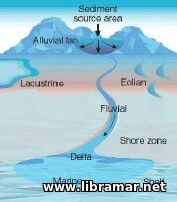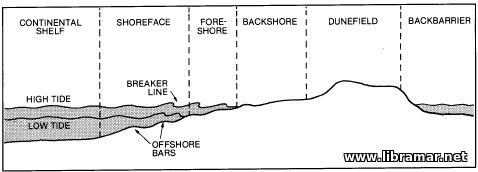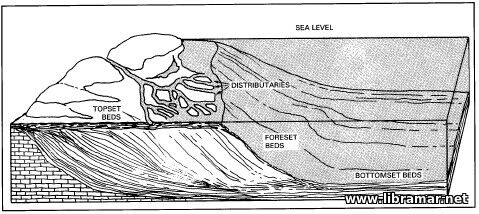Sedimentary Rocks

For the petroleum geologist, sedimentary rock is the most interesting type of rock. Some sedimentary rock formations are porous enough to hold great quantities of oil and gas; others contain high proportions of the organic matter from which, under certain conditions, hydrocarbons are generated.
Sedimentary rock is rock made up of fragments or chemical compounds from previously existing rocks or organisms. Carried by flowing water, ice, or air in response to the force of gravity, sediment accumulates in upland basins and along the edges of the continents. The depth of an accumulation can reach several miles. Deeply buried sediments are transformed into hardened rock by a set of processes called, collectively, lithification. The processes that alter the rock itself, either during or after its formation, are called diagenesis.
Compaction and cementation are two of the principal processes that change sediments into rock. As successive layers of water-saturated sediment accumulate, the deeper layers are compacted by the weight of overlying beds. The individual grains are forced into closer contact and, in some cases, are deformed. Minerals dissolved in the water-commonly, calcite form a solid material that cements the grains together. Much of the water is squeezed out as the sediment is transformed into rock, but some becomes trapped in the pores as connate, or interstitial, water. Rock formed from sediments deposited by water almost always contains interstitial water.
rock. As successive layers of water-saturated sediment accumulate, the deeper layers are compacted by the weight of overlying beds. The individual grains are forced into closer contact and, in some cases, are deformed. Minerals dissolved in the water-commonly, calcite form a solid material that cements the grains together. Much of the water is squeezed out as the sediment is transformed into rock, but some becomes trapped in the pores as connate, or interstitial, water. Rock formed from sediments deposited by water almost always contains interstitial water.
Close study of sedimentary rock reveals the conditions under which it was formed. One set of conditions includes the events that occur beneath the surface during lithification and diagenesis compaction, cementation, and chemical alteration by groundwater. The natural conditions that most influence the character of sedimentary rock are, however, those that occur at the earth's surface, where the solid earth is in contact with the fluids of the atmosphere and the oceans and where plants and animals live. The set of physical, chemical, biological, and geologic conditions under which the original sediments of a given rock layer were laid down are called the depositional environment.
 Sediments accumulate in characteristic patterns and locations relative to the continental masses. As a continent moves away from a mid-ocean ridge, its trailing edge subsides; here, thick layers of clay from the land and lime mud from marine organisms accumulate in the shallow sea on the continental shelf. The advancing edge of a continent may be crumpled and broken in mountainous fold belts and over thrust belts; coarse, jumbled gravels from these mountain ranges accumulate in the adjacent lowlands. In places, the crust is pulled apart by deep-rooted forces and forms down dropped basins called grabens; here, sediments may accumulate to depths of several miles as the basin deepens.
Sediments accumulate in characteristic patterns and locations relative to the continental masses. As a continent moves away from a mid-ocean ridge, its trailing edge subsides; here, thick layers of clay from the land and lime mud from marine organisms accumulate in the shallow sea on the continental shelf. The advancing edge of a continent may be crumpled and broken in mountainous fold belts and over thrust belts; coarse, jumbled gravels from these mountain ranges accumulate in the adjacent lowlands. In places, the crust is pulled apart by deep-rooted forces and forms down dropped basins called grabens; here, sediments may accumulate to depths of several miles as the basin deepens.
In any sedimentary basin, the type of sediment that accumulates depends largely on the energy of the water that deposits it: higher energy means larger grains. A fast-flowing, energetic stream carries off small particles, leaving behind coarser sediments such as gravel and boulders. Thus, coarse sediment indicates a high-energy depositional environment.
The variability of the energy level affects the uniformity of grain size-that is, sorting. A non-separated collection of different-sized particles is said to be unsorted or poorly sorted. A dry desert arroyo where flash flooding sometimes occurs tends to collect a jumble of unsorted sediment; a steady stream that flows year-round deposits well-sorted layers of particles similar in size and shape. Grading is an indication of a variable energy level, as in a wet/dry climate cycle. A stream may flow swiftly in the wet season, depositing coarse sediments, then gradually slackening, overlaying a succession of ever finer materials.
A classification scheme for depositional environments is shown in this table. Each environment listed can include many types of sediments, but each environment has a characteristic assemblage of types. Typical stream deposits, for example, range from gravel and boulders in areas of high flow velocity and turbulence to fine silt and clay in the floodplain flanking the main channel. Deposition along a stream bank is characterized by an overlapping series of sandbars and clay sheets, with ripple marks and other flow features preserved on the top of each layer.
features preserved on the top of each layer.
An intermittent desert or mountain stream that is prone to flash flooding typically dumps its load of unsorted materials in an alluvial fan, a chaotic jumble of boulders, gravel, sand, and clay found where the gradient flattens out.
The energy level along a beach is moderate and relatively constant. Wave action suspends fine clay particles, carrying them out to quieter offshore areas, but leaves clean, well-sorted sand at the water line. High-energy deposits are concentrated in the surf zone and in the backshore zone between high tide and storm tide levels; low-energy, fine sediments occur seaward of the shore face and in sheltered lagoons.
The depositional environments grades into one another in a variety of ways. For example, the wind is a significant depositional factor not only in deserts far from the sea, but also along many of the world's seacoasts, where it piles sand into great dunes beyond the reach of the tide. A sabkha is a shallow desert basin where infrequent runoff collects and evaporates, leaving thin alternating  layers of clay and evaporates; sabkhas are found both far inland and along arid coastlines. Fluvial and beach sediments often overlap and interweave as shifting shorelines are cut by rivers; both are characterized by sandbars, but the orientation of these deposits and the shape and arrangement of their sand grains differ.
layers of clay and evaporates; sabkhas are found both far inland and along arid coastlines. Fluvial and beach sediments often overlap and interweave as shifting shorelines are cut by rivers; both are characterized by sandbars, but the orientation of these deposits and the shape and arrangement of their sand grains differ.
When a river reaches the coastline, its flow energy dissipates in the sea. No longer able to transport its solid load, the stream deposits sediments in a delta. A typical marine delta is a fan-shaped body of sediments projecting beyond the normal coastline.
Its top-set beds, essentially a seaward extension of the stream channel, contain clay, silt, sand, and gravel in patterns much like those of the continental lowland drainage. Fore-set beds, on the steep seaward face of the delta, are composed of silt and clay; bottom-set beds, beyond the delta face where the river's flow energy is finally dissipated in the sea, consist mostly of fine clays. The same general pattern prevails in a lacustrine delta, where a stream enters a freshwater lake.
On a growing delta, the river's mouth may shift from one part of the delta to another as sediments block channels and flow seeks the easiest path across it. This shifting causes a delta to build up in a series of overlapping lobes. In the last 5000 years, the active lobe of the Mississippi Delta has shifted from what is now the mouth of the Atchafalaya River to its present location southeast of New Orleans.
The continental shelf, a true marine environment beyond the deltas and beaches of the transition zone, is characterized by fine clastic sediments, often with an abundance of organic material, which forms shale. In warmer climates, carbonate mud may accumulate to great thickness to form limestone.
Such marine rock assemblages now account for most of the world's known petroleum reserves. One of the largest oilfields, the Ghawar in Saudi Arabia, occurs in a folded limestone formation.
Ghawar in Saudi Arabia, occurs in a folded limestone formation.
At times in the geologic past, shallow arms of the sea extended far into the interior of the continents. Sedimentation patterns in these epeiric seas were much like those of the present continental shelves. Some of the inundated areas, however, were so far from the open sea that they were almost landlocked, like the present Baltic Sea of northern Europe. Epeiric seas near the equator, warmed by the tropic sun, supported rich communities of marine plants and animals, which later contributed their organic material to the formation of thick sequences of shales and limestones. As water evaporated and was replaced by inflow from the sea, salt concentrations often rose so high that salt precipitated out to form salt beds on the seafloor.
The "Read Later" function allows you to add material to this block with just one click. Just click on the icon and read the articles that interest you at any convenient time.


